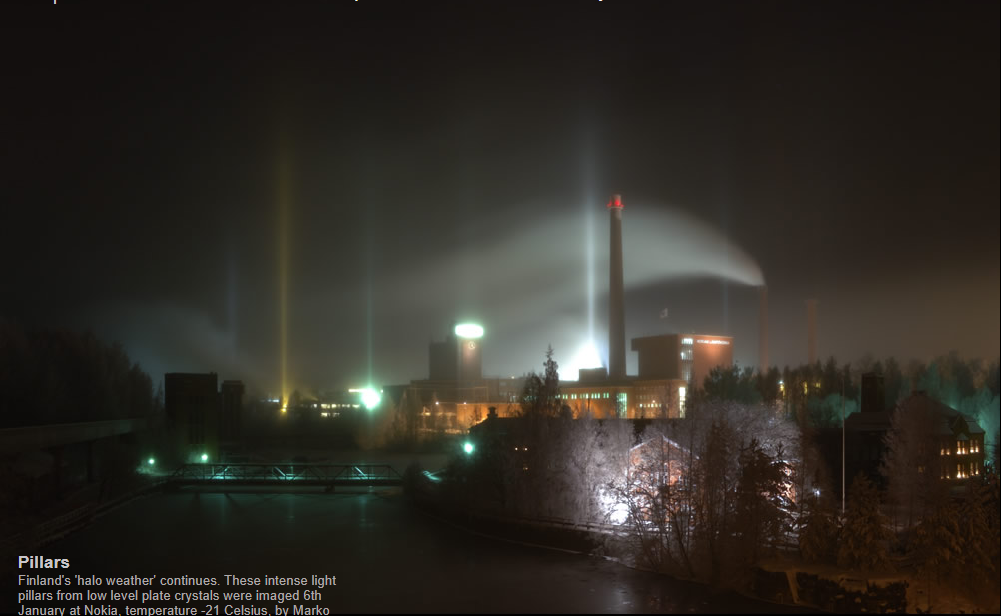Pillars Galore
Pillars Galore: A Spectacular Atmospheric Optics Phenomenon
Have you ever looked up at the sky and been amazed by the beauty of the natural world? Atmospheric optics is a fascinating field that explores the optical phenomena that occur in our atmosphere. One such phenomenon that never fails to captivate observers is the appearance of pillars. These pillars, also known as light pillars, are vertical columns of light that seem to extend into the heavens. In this article, we will delve deeper into the world of pillars, exploring their formation, characteristics, and the mesmerizing sights they create.
The Marvel of Light Pillars
Light pillars are optical phenomena that occur when light is reflected or refracted by ice crystals in the atmosphere. These crystals can be found in various forms, such as hexagonal plate crystals or columnar ice crystals. When the conditions are just right, light from artificial sources or natural celestial objects, like the Sun or Moon, interacts with these ice crystals, creating a stunning display of vertical columns of light.
Unveiling the Formation Process
To witness the enchanting sight of light pillars, specific conditions must align. Firstly, the air must be extremely cold, typically below freezing temperatures. Secondly, there must be a source of light, either natural or artificial, such as streetlights or the Moon. Finally, there should be a sufficient concentration of ice crystals in the air. When these elements come together harmoniously, the stage is set for the formation of light pillars.
Understanding the Optical Illusion
When light encounters ice crystals in the atmosphere, it undergoes a process called refraction. Refraction is the bending of light as it passes from one medium to another. In the case of light pillars, the incoming light is refracted by the hexagonal ice crystals, causing it to change direction and bend towards the observer's eyes. This bending effect creates the illusion of vertical columns of light extending into the sky.
The Mesmerizing Pillar Varieties
Light pillars come in various forms, each with its own unique characteristics. The most common type is the vertical pillar, where the light appears as a tall column extending upwards. However, light pillars can also manifest as shorter columns or even appear slanted due to the orientation of the ice crystals. In some cases, multiple pillars can be observed simultaneously, creating a truly awe-inspiring spectacle.
The Wonders of 'Halo Weather'
Certain regions, such as Finland, are known for their frequent occurrences of light pillars due to their cold climates and high concentrations of ice crystals in the air. This phenomenon, often referred to as 'halo weather,' provides an ideal environment for the formation of these captivating optical displays. Photographers and enthusiasts flock to these regions to capture the breathtaking beauty of pillars galore.
Capturing the Magic
Photographing light pillars can be a rewarding experience for both amateur and professional photographers. To capture these elusive phenomena, one must be prepared with the right equipment and techniques. Using a sturdy tripod and a long exposure setting on the camera can help capture the intricate details and ethereal glow of the light pillars. Patience and perseverance are key, as the appearance of these phenomena is unpredictable and fleeting.
Expanding Our Knowledge
While light pillars have been observed and documented for centuries, there is still much to learn about their intricacies and variations. Scientists continue to study the formation processes of these optical wonders, exploring how different types of ice crystals and atmospheric conditions contribute to their appearance. By expanding our knowledge of light pillars, we gain a deeper understanding of the complex interactions between light and ice in our atmosphere.
A Window into Atmospheric Optics
Light pillars serve as a reminder of the hidden beauty that surrounds us in the natural world. They provide a glimpse into the fascinating field of atmospheric optics, where light interacts with various atmospheric elements to create stunning visual displays. By studying and appreciating these phenomena, we gain a greater appreciation for the intricate workings of our atmosphere and the wonders it can produce.
Embracing the Spectacle
Next time you find yourself under a clear, frigid sky, take a moment to look up and marvel at the spectacle of light pillars. These captivating columns of light offer a glimpse into the magical world of atmospheric optics. Whether you're a seasoned photographer or simply an admirer of nature's wonders, the sight of pillars galore is sure to leave you in awe of the remarkable beauty that exists just beyond our reach.

Pillars
Finland's 'halo weather' continues. These intense light pillars from low level plate crystals were imaged 6th January at Nokia, temperature -21 Celsius, by Marko Riikonen (site, More of January's pillars). �Marko Riikonen, shown with permission.
Note: this article has been automatically converted from the old site and may not appear as intended. You can find the original article here.
Reference Atmospheric Optics
If you use any of the definitions, information, or data presented on Atmospheric Optics, please copy the link or reference below to properly credit us as the reference source. Thank you!
-
<a href="https://atoptics.co.uk/blog/pillars-galore/">Pillars Galore</a>
-
"Pillars Galore". Atmospheric Optics. Accessed on April 24, 2024. https://atoptics.co.uk/blog/pillars-galore/.
-
"Pillars Galore". Atmospheric Optics, https://atoptics.co.uk/blog/pillars-galore/. Accessed 24 April, 2024
-
Pillars Galore. Atmospheric Optics. Retrieved from https://atoptics.co.uk/blog/pillars-galore/.